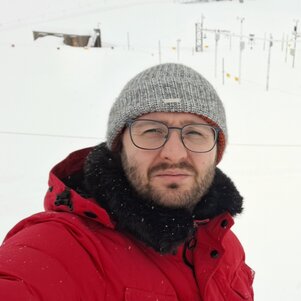Measuring 1 million snowflakes for better weather forecasts
Taking the ski lift to work. That's not something many people can say. For postdoc and TU Delft alumnus Koen Muller, this has been a reality for almost 1 year. Next to a ski slope near Davos, he is building a unique measurement setup with which he wants to collect data on snowstorms to gain more insight into the interaction of snowflake aggregation and atmospheric turbulence. If successful, he will hold a unique dataset that will help improve weather prediction and climate models.
Flows are all around us, and that fascinates Koen Muller. During his PhD project at the Faculty of Mechanical Engineering, he studied the movement of a school of fish in the Oceanium at Blijdorp Zoo. Not comparable to any snowstorm, you might say, but Muller sees that differently. "They are both complex currents consisting of multiple phases, which means that there is a flow with particles in it," says Muller. "Whether that's in air or water and with fish or snowflakes, that doesn't really matter. The main interest is in the emerging flow dynamics."
At nature's mercy
Muller's research is not standard within fluid dynamics. "Most experiments and measurements within this field are performed in a lab environment where you control all conditions, such as flow velocity, temperature and humidity." But instead, Muller wants to measure in nature. That sounds logical, but is still quite unique within fluid dynamics because it presents significant challenges. "You totally give up being in control and are at the mercy of the elements," he says. His PhD project was a first step towards measuring flows directly in nature.
"The school of herring we examined seems to behave like a liquid. How is it possible that all the fish are swimming together without colliding? With newly developed measurement and camera systems, we mapped the movement of each individual fish to gain full insight into the movement of the school as a whole." Never before has the movement of a school of fish been mapped so accurately.
Confetti in the lab
Muller has spent the past year in Switzerland mainly developing and building a camera system similar to the one in Blijdorp. Besides the fact that conditions on a snowy mountain are even more challenging than in an aquarium, the area Muller wants to investigate is also much larger. He eventually wants to map a snowstorm over 20x20x20 metres. Muller first tested the camera equipment in a lab at ETH Zurich, where he is doing his postdoc. To fine-tune the settings, they used confetti as a substitute for snow. Meanwhile, the measurement system, consisting of 16 cameras, is being tested at 2 kilometres altitude on the Weissfluhjoch.
Rubicon grant
Muller recently received a Rubicon grant from NWO. This will allow him to conduct research in Switzerland for another two years. He is very honoured to receive this grant and calls it a unique opportunity that gives him more freedom. "That's a great luxury as a young researcher," he says. Muller expects to start measuring full-time next winter. Because snowflakes are easier to distinguish and capture against a dark background, this will mainly take place at night. That will be a lot of nights on the mountain. But Muller is certainly up for that.
"Within fluid dynamics, there is hardly any data from the outside world. If we can capture just one snowstorm, it will provide an awful lot of useful and unique data." Ultimately, Muller hopes to capture 1 million snowflakes. Naturally, that will also yield a huge amount of data that will then need to be analysed. "Ultimately, we hope to find in that pile of data the answer to the question of how snow density and fall velocity relate to each other."
Beauty in flows
So now the wait is on for the perfect snow storm to be captured properly. Muller is looking forward to it. "The fall of snow against a dark background has an almost hypnotic effect. There is a beauty in capturing flows," he thinks. Ultimately, Muller hopes his data can be used to provide more insight into current weather and climate predictions.
